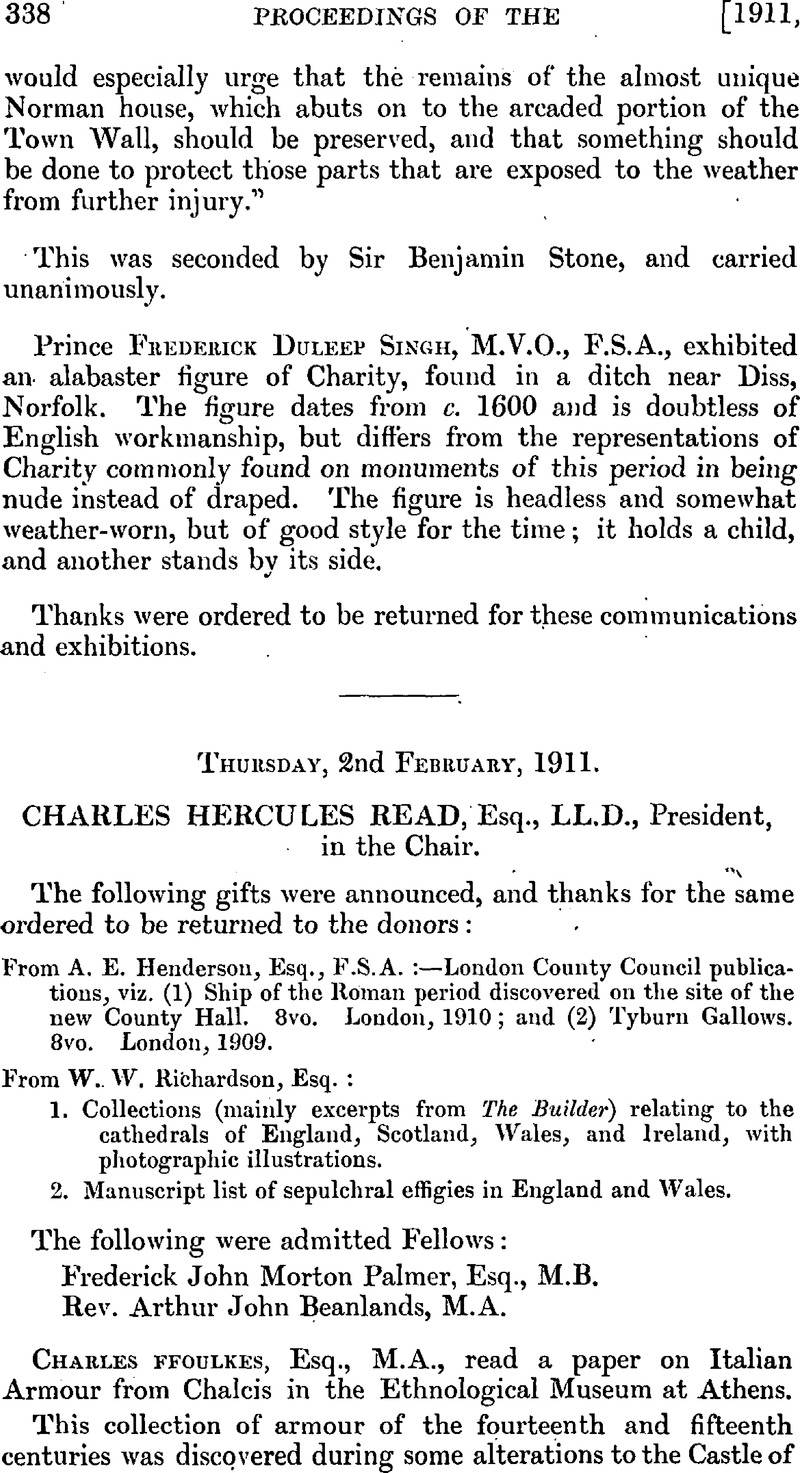No CrossRef data available.
Article contents
Thursday, 2nd February, 1911
Published online by Cambridge University Press: 10 May 2010
Abstract

- Type
- Proceedings
- Information
- Copyright
- Copyright © The Society of Antiquaries of London 1911
References
page 340 note 1 Notes and Queries, 1863, pp. 328, 416, 460, 516 ; 1903, p. 308.
page 340 note 2 Archaeologia, xviii, p. 306 ; Gentleman's Magazine, 1803, p. 497. The ring was unearthed in Coventry Park near the town wall by a person digging potatoes.
page 341 note 1 Probably once enamelled, though all traces of enamel are now lost.
page 341 note 2 Notes and Queries, 1872, p. 330. The inscriptions are almost identical with those of the other two rings.
page 342 note 1 Cf. Canon Sparrow Simpson's article mentioned below, pp. 370, 371 ; see also Arch. Journ. xxvi, p. 233. The kings occur with Vulnera quinque Dei, & c., in the Stockholm Magical MS., but as a charm against fever (Archaeologia, xxx, p. 400).
page 342 note 2 For Ananizapta see Archaeologia, xxx, p. 427; Journ. Brit. Arch. Assoc., xl, p. 311 ; Arch. Journ. iii. 358 ; xxvi. 230.
page 342 note 3 For the above facts, see E. Mâle, L'art religieuv de la fin du, Moyen Âge, pp. 100–2.
page 342 note 4 See the paper by Canon Sparrow Simpson entitled ‘On the measure of the wound in the side of the Redeemer’, in Journal of the British Arch. Association, xxx. 357 sqq., where the De quinque Vulneribus Jesu Christi of Quaresmius is quoted. Representations of the great wound were woru as charms. The wounds appear not only in MSS. but in larger works of art of various kinds, such as monumental brasses and sculpture in wood and stone.
page 342 note 5 This shield, now in the window, of the vestry, measures 8 in. × 7¼ in. It was photographed for me by Mr. A. W. Ellis, by kind permission of the Vicar, the Rev. H. G. Clements.
page 342 note 6 The example from Quarrendon (now destroyed), to which Lord Dillon draws attention (p. 344),- was upon a quarterly shield, drawn in the MS. to which he refers. Here, however, the wounded hands and feet appear, and not the wounds alone.
page 343 note 1 It belongs to the Duchess of Norfolk, and is described, with a halftone block, in the Journal of the Yorkshire Archaeological Society, vol. xxi, pp. 108–9. I am indebted for this reference to Mr. Mill Stephenson.
page 343 note 2 One, from the site of Tichfield Abbey, Hants, is now, as the Rev. G. W. Minus informs me, in private possession. Another is in the collection of Sir. Arthur Evans.
page 343 note 3 The introduction of the Virgin and St. John, or of angels, to support the body of Christ is perhaps Italian, as also may be the representation of the body within a tomb or sarcophagus. The greatest presentation of the type so conceived is found in the pictures of Giovanni Bellini iu the Brera, at Rimini, at Berlin, and in the Mond Collection in London.
page 344 note 1 L'art religieux de la fin du Moyen Âge en France, 91 if. Examples of the engraving are at Paris, Berlin, and Vienna : there is no copy in our own public collections.




